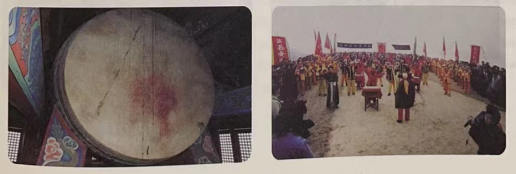申报地区:偃师市 2020年08月 第4批扩展项目
相传东汉末年,京城洛阳制鼓艺人为躲避董卓之乱,迁居京畿缑氏县柏谷坞(今柏谷坞村,与金屯村、马屯村相邻)一带,成为缑氏制鼓业的发端。
清朝同治年间,金屯村回族皮匠马廷召及儿子马仁义,拜当地老艺人为师,学习传统制鼓技艺。马向阳在先人技艺的基础上,开发出战鼓、大鼓、排鼓、腰鼓等10大类30多个品种鼓类。马氏传统制鼓技艺分五步,分别是:生皮精制鼓皮,裁解月牙板,销钉合鼓圈,打摽踩鼓面,着钉上鼓环。鼓皮精选带血气的生牛皮,月牙板拼合鼓圈时,用钉竹木销钉拼接。最为独特是踩鼓,先绑好井字架、压上两个磨盘、上放木盘,放好蒙皮的鼓圈,再绕绳打摽,接着1-2名壮汉赤脚上到鼓面上,反复踩鼓。
缑氏镇是远近闻名的制鼓之乡,北京、西安鼓楼大鼓均为缑氏镇制作,1997年,为香港回归活动捐赠大鼓20面,2008年为北京奥运会特制大鼓2008面。产品还远销日本、韩国及东南亚地区。

It is said that at the end of the Eastern Han Dynasty(25 AD- 220 AD), in order to avoid the Dong Zhuo's disordered administration, the drum makers in Luoyang moved to Goushi County which gradually became the place of origin for Goushi drum making industry. During the Tongzhi period of the Qing Dynasty (1862 AD-1874 AD), Ma Tingzhao, a leather craftsman of the Hui nationality learned the traditional drum making skills from the local artists, and developed more than 30 kinds of drums in 10 categories. The traditional drum making includes refining the drum skin with raw hide, cutting off the crescent plate, combining the pin with the drum ring, beating the drum surface and putting the pin on the drum ring.The kin of the drum is made from fresh cow leather. When the crescent plate is used to assemble the drum ring, it is spliced with bamboo and wood pins. The most unique way is to step on the drum. First, tie up the "#t-shaped"frame, press on two grinding plates, put on the wooden plate and then the drum ring of the skin, turn the rope around. Then 1-2 strong men go barefoot to the drum surface and step on the drum repeatedly Goushi is a well-known for making drum sold far to Drum Towers in Beijing and Xian. In 1997, 20 big drums were donated for Hong Kong's in celebration of its return to the motherland, and 2008 big drums were specially made for the Beijing Olympic Games. They are also exported to Japan, South Korea and Southeast Asia.
